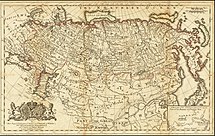Russian colonization of North America: Difference between revisions
m seems wikified |
|||
| Line 2: | Line 2: | ||
{{nofootnotes|date=July 2008}} |
{{nofootnotes|date=July 2008}} |
||
{{tooshort|date=July 2008}} |
{{tooshort|date=July 2008}} |
||
{{wikify|date=July 2008}} |
|||
{{Refimprove|date=September 2007}} |
{{Refimprove|date=September 2007}} |
||
{{euromericas}} |
{{euromericas}} |
||
Revision as of 14:05, 6 August 2008
This article provides insufficient context for those unfamiliar with the subject. (July 2008) |
This article includes a list of references, related reading, or external links, but its sources remain unclear because it lacks inline citations. (July 2008) |
This article needs additional citations for verification. (September 2007) |
| Part of a series on |
| European colonization of the Americas |
|---|
 |
|
|
| History of Russia |
|---|
 |
|
|
Russian colonization of the Americas proceeded in several places.
Alaska
Europeans first sighted the Alaskan coast line in 1732; sighting was made by the Russian Ivan Fedorov near Cape Prince of Wales, but he did not land. The first landfall took place in southern Alaska in 1741 during the Russian exploration conducted by Vitus Bering and Aleksei Chirikov. The first Russian colony in Alaska was founded in 1784 by Grigory Shelikhov. The Russian-American Company was formed in 1799 with the influence of Nikolay Rezanov for the purpose of hunting sea otters for their fur. The peak population of the Russian colonies was about 40,000, although most of these were Aleuts. The Russians also expanded and explored into modern day British Colombia, forming trading outposts and hunting settlements.
The colony was hardly ever profitable, due to transportation costs. At the instigation of Secretary of State William H. Seward, the U.S. Senate approved the purchase of Alaska from the Russian Empire for 2 cents an acre, totaling $7,200,000 ($95,672,993 adjusted for inflation in 2006 dollars) on April 9, 1867.
In modern Russia and its predecessor, the Soviet Union, there has been speculation in the mass media that Alaska was not sold, but merely leased to the U.S. for 99 or 150 years and has to be returned to Russia. However, the treaty itself is quite clear that it was a complete cession. The speculation may be explained in part by the notion that after the 1917 revolution in Russia all secret tsarist international agreements were officially denounced and declared void by the new government.
A hundred-pound bell was unearthed in an orange grove near Mission San Fernando Rey de España, Southern California, in 1920. It carried the following inscription (translated from Russian): "In the Year 1796, in the month of January, this bell was cast on the Island of Kodiak by the blessing of Archimandrite Joaseph, during the sojourn of Alexandr Baranov." It is not known how this Russian Orthodox artifact from Kodiak, Alaska, made its way to a Roman Catholic mission in Southern California, though its existence provides proof of the Russian diaspora on the Pacific Rim and its intertwining with Spanish and Native American cultures.
The Russian Orthodox Church Outside Russia and the Orthodox Church in America can trace activities back to early Russian missionaries. Herman of Alaska, Saint Innocent of Alaska and Peter the Aleut have contributed to the strong Orthodox community in Alaska.
A series of commemorative coins was released in the USSR in 1990 and 1991 to commemorate the 250th anniversary of the discovery of Russian America. It consisted of a silver coin, a platinum coin and two palladium coins in each year.
Elsewhere in North America
Subsequently, Russian explorers and settlers continued to establish trading posts in Alaska, the Aleutian Islands, British Columbia, Washington, Oregon and as far south as Fort Ross in northern California. Fort Ross, some 50 miles north of San Francisco, was founded in 1812 and closed in 1841. El Presidio Real de Sonoma, or Sonoma Barracks, was established at Sonoma, California in 1836 by Mariano Guadalupe Vallejo (the "Commandante-General of the Northern Frontier of Alta California") as a part of Mexico's strategy to halt Russian incursions into the region.
See also
- Grigory Shelikhov
- Alexandr Baranov
- Mikhail Tebenkov
- Johan Hampus Furuhjelm
- Nikolai Rezanov
- Battle of Sitka
- Saint Innocent of Alaska
- Yevgeniy Tsvetov
- Kseniya Galper
- Russian American
- List of ships in British Columbia
- History of the west coast of North America
External links
- Wikipedia articles needing context from July 2008
- Wikipedia introduction cleanup from July 2008
- Articles covered by WikiProject Wikify from July 2008
- Colonization of the Americas
- History of Alaska
- History of Russia
- History of the administrative divisions of Russia
- Fur trade
- History of British Columbia
- History of the Yukon
- History of California


